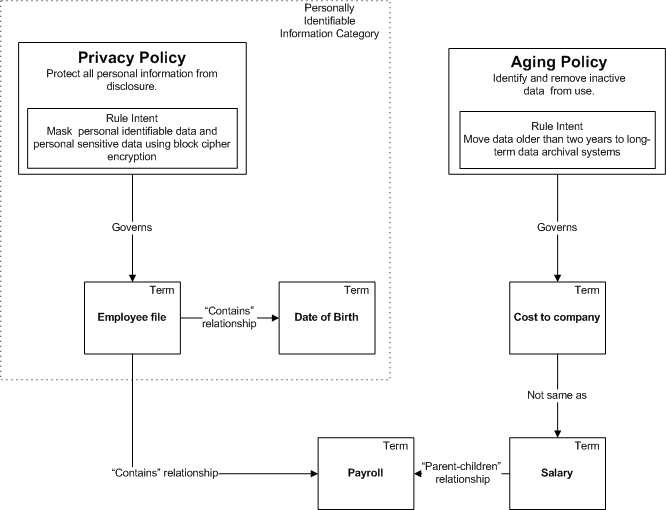Glossary Content Relationship Example
You are the data steward who is responsible for the human resources glossary. Create and relate business terms, policies, and categories as shown in the example.
You can create the following relationships between Glossary assets:
- •Use default relationships to relate business terms.
- •Use policies to govern business terms.
- •Classify policies and business terms in categories.
The following image shows Glossary assets and their relationships:
Create the following policies to govern business terms:
- Privacy policy
- The privacy policy states that private information must not be disclosed. The privacy policy has a rule intent that private information must be masked to protect disclosure of employee data. An employee file contains personal information such as employee date of birth. Use the privacy policy to indicate that the date of birth of an employee must not be disclosed, and data must be masked in the database to prevent accidental disclosure.
- Aging policy
- The aging policy states that inactive data must not be used. Govern "cost to company" by the aging policy because the employee data defined by the term "cost to company" changes every financial year.
Create the following category to classify business terms and policies:
- Personally identifiable information.
- Classify the privacy policy, "employee file" and " date of birth" terms in the "personally identifiable information" category for glossary consumers who want to view assets related to personally identifiable information.
Create the following relationships between business terms:
- Contains relationship
- An employee file contains details such as employee date of birth and payroll information. Use the "contains" relationship to link the term "employee file" with the term "date of birth" and the term "payroll."
- Parent-child relationship
- Employee payroll is calculated from the employee salary. The parent term is "salary" and the child term is "payroll."
- Not same as
- Cost to company is often incorrectly used to denote salary. Use the "not same as relationship" to indicate that "salary" and "cost to company" do not have the same meaning.

